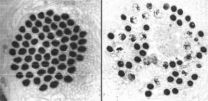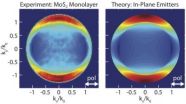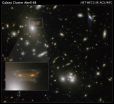(Press-News.org) PROVIDENCE, R.I. [Brown University] — For a bunch of inanimate chemical compounds, the nucleic and amino acids caught up in the infamous "selfish" segregation distorter (SD) saga have put on quite a soap opera for biologists since the phenomenon was discovered in fruit flies 50 years ago. A new study, a highlight in the March issue of the journal Genetics, provides the latest plot twist.
In TV listings the series would be described this way: "A gene exploits a rival gene's excesses, sabotaging any sperm that bear the rival's chromosome." The listing is not an exaggeration except for ascribing malicious intent to strings of biochemicals. When male flies make their sperm, the SD gene (call it "A") manages to rig meiosis — the specialized cell division that makes sex cells — so that maturing sperm that bear chromosomes with the susceptible allele (call that one "a") end up defective and discarded. They never even leave the testes.
It is murder of a sort. Similar selfish systems occur in mammals, including humans.
In the Genetics study conducted at Brown University, scientists uncover new clues about how the SD gene might be gaming the system against "a." It's a plot so fiendish, only an aggregation of genetic bases could evolve it. It also deepens biologists' understanding of an instance in which life violates a fundamental balance predicted by the father of genetics, Gregor Mendel.
"Mendel's first law is that different alleles of a gene will segregate," said Robert Reeenan, professor of biology and the study's senior author. "If we have two alleles — big A and little a — then Mendel says 50 percent of the sperm at random will get the big A and 50 percent of the sperm will get the little a. But some SD (A) alleles are so strong they pretty much kill off all the non-SD (a) chromosomes.
"This is a real cheater, a real stinker," Reenan said. "Most genes, like most people, are good upstanding citizens, but some genes want to hog all the resources, hog all the benefit."
The SD backstory
What makes the "a" allele susceptible to SD's subterfuge is the number of copies it harbors of a runaway snippet of genetic code called Responder. A few copies of Responder are no problem, but hundreds of copies make "a" susceptible. Some alleles have thousands of copies and only one in a thousand survives.
Genomes try to root out parasites like Responder by creating and dispatching proteins into the nucleus and the cytoplasm. These police proteins are armed with "police sketches" of the parasites in the form of small RNA transcripts.
The new plot twist
It struck Reenan and lead author Selena Gell that this policing system — because it targets self-copiers like Responder — might somehow have a role in the SD saga. They decided to find out by purposely perturbing the system.
In the experiments described in Genetics, Reenan and Gell show that engineered mutations in the police gene named Aubergine (others on the force in the experiments are called Piwi, Squash, and Zucchini) amplify SD chromosomes' success in eliminating Responder-laden sperm, compared to that of SD chromosomes without Aubergine's help. The results show that this police system suppresses Responder, and therefore SD. It also means that if SD somehow can upset the policing system, it can have a field day.
"We're the first to have experimentally shown that mutations in the system can modify the degree of distortion," Reenan said. "We used homologous recombination to knock in a mutation specifically on the SD chromosome to compromise Aubergine, and that's exactly what we saw: the chromosome became more selfish."
Reenan and Gell did not go so far as to determine whether known SD-promoting genes called Enhancer of SD, Stabilizer of SD, and Modifier of SD act by interfering with Aubergine or its buddies on the force, but Reenan said that is among the next things his group will look into.
In the meantime, he reflects, it may not be entirely fair for biologists to label SD as "selfish" and not Responder as well. As an out-of-control self-repeater in the genome, Responder is surely no prize, and SD performs something of a service by taking it out when it can.
The whole story is really a clash of the selfish. "Humans, flies, all of us have been attacked for millennia by selfish genetic elements that want to make as many copies as possible," Reenan said.
Sometimes, as in SD flies, there are no apparent ill effects, but when the selfish genes come in the form of viruses or other kinds of transposons, there can be trouble. So investigating the tactics of selfish genes is not merely the stuff of biological soap operas.
INFORMATION:
Gell, who was supported by a National Science Foundation Predoctoral Fellowship during the research, is now a postdoctoral scholar at Harvard University.
Does the villainous 'selfish' gene undermine genome's police?
Genetics paper a new entry in the Segregation Distorter saga
2013-03-05
ELSE PRESS RELEASES FROM THIS DATE:
Colonoscopy screening reduces risk of advanced colorectal cancer
2013-03-05
Philadelphia - A new study led by a researcher at the Perelman School of Medicine at the University of Pennsylvania adds support to current medical recommendations stating that screening colonoscopy substantially reduces an average-risk adult’s likelihood of being diagnosed with advanced colorectal cancer (CRC) in either the right or left side of the colon. In recent years, colonoscopy has begun to rapidly replace sigmoidoscopy – a procedure used to detect abnormalities in the rectum and left side of the colon – despite initially limited evidence of its efficacy and higher ...
New spectroscopy method could lead to better optical devices
2013-03-05
PROVIDENCE, R.I. [Brown University] — A multi-university research team has used a new spectroscopic method to gain a key insight into how light is emitted from layered nanomaterials and other thin films.
The technique, called energy-momentum spectroscopy, enables researchers to look at the light emerging from a thin film and determine whether it is coming from emitters oriented along the plane of the film or from emitters oriented perpendicular to the film. Knowing the orientations of emitters could help engineers make better use of thin-film materials in optical devices ...
Shadows over data sharing
2013-03-05
In a paper about to be published in EPJ Data Science, Barbara Jasny, deputy editor for commentary at Science magazine in Washington, DC, USA, looks at the history of the debates surrounding data access during and after the human genome "war". In this context, she outlines current challenges in accessing information affecting research, particularly with regard to the social sciences, personalised medicine and sustainability.
The trouble is that most researchers do not currently share their data. This is due both to research practices and research culture. Scientists withholding ...
Herbal defluoridation of drinking water
2013-03-05
Researchers in India have developed a filter system based on a medicinal herb, which they say can quickly and easily remove "fluoride" from drinking water. The technology described in the March issue of the International Journal of Environmental Engineering uses parts of the plant Tridax procumbens as a biocarbon filter for the ion.
Drinking water can contain natural fluoride or fluoride might be added as a protective agent for teeth by water companies. However, its presence is not without controversy while in some natural drinking water levels may be above those considered ...
Kirk, Spock together: Putting emotion, logic into computational words
2013-03-05
Kirk and Spock may not need a Vulcan mind meld to share cognition: Virginia Tech Carilion Research Institute scientists have found that our cold reasoning and hot feelings may be more intimately connected than previously thought.
"We tend to believe we have rational parts, like Spock, and separate emotional parts, like Kirk. But our research suggests that's not true," said Read Montague, director of the Human Neuroimaging Laboratory at the Virginia Tech Carilion Research Institute, who led the study. "We're all a combination of logical Spock and intuitive Kirk. Cold ...
When good food goes bad
2013-03-05
MARCH 5, 2013—Baltimore, MD—The Center for Biosecurity of UPMC today released online ahead of print a new report, When Good Food Goes Bad: Strengthening the US Response to Foodborne Disease Outbreaks. The authors analyzed existing data and studies on foodborne illness outbreak response, identified emerging trends, and interviewed dozens of federal and state-level officials and experts from industry, professional organizations, academia, and relevant international organizations. The report puts forth a series of recommendations to accelerate and strengthen responses to foodborne ...
Nurse migration in North and Central America strengthening health systems
2013-03-05
International nurse migration is a multibillion-dollar global phenomenon. Historically, Mexicans and Central Americans have not played a significant part in the migration of nurses to the United States. A new report, Strengthening health systems in North and Central America: What role for migration?, sponsored by the Migration Policy Institute (MPI), seeks to draw attention to the cross-border migration in the Americas and suggests ways the migration could be managed to meet the demand for health care services in the region.
The report, co-authored by New York University ...
Gravitational lens creates cartoon of space invader
2013-03-05
The gravitational field surrounding this massive cluster of galaxies, Abell 68, acts as a natural lens in space to brighten and magnify the light coming from very distant background galaxies.
Like a fun house mirror, lensing creates a fantasy landscape of arc-like images and mirror images of background galaxies. The foreground cluster is 2 billion light-years away, and the lensed images come from galaxies far behind it.
In this photo, the image of a spiral galaxy at upper left has been stretched and mirrored into a shape similar to that of a simulated alien from the ...
EARTH: Releasing a flood of controversy on the Colorado River
2013-03-05
Alexandria, VA – As the Colorado River winds through the Colorado Plateau's soft sedimentary strata, it picks up a tremendous amount of sediment. This sediment – which once left the river's waters so muddy that Spanish explorers christened it El Rio Colorado "the reddish river" – is a vital component to the unique ecosystems of the river. However, with the construction of the Hoover and Glen Canyon dams, which trap the sediment, the once-turbid waters have become a dazzling blue-green, signaling major changes with serious implications for the health of the river's native ...
Is the iPad creative? It depends on who's buying it
2013-03-05
Encouraging consumers to feel ownership of products they haven't yet purchased can backfire because consumers tend to see themselves in the products they own, according to a new study in the Journal of Consumer Research.
"Companies assume that consumers who are made to feel ownership of a product prior to purchase will prefer it over competing products, but this can actually have the opposite effect and lead consumers to judge the product less favorably," write authors Liad Weiss and Gita V. Johar (both Columbia University).
Companies encourage us to feel a sense of ...
LAST 30 PRESS RELEASES:
Jeonbuk National University study shows positive parenting can protect adolescents against self-harm
Surface-engineered ZnO nanocrystals to tackle perfluoroalkyl substance contamination
This new understanding of T cell receptors may improve cancer immunotherapies
A new fossil face sheds light on early migrations of ancient human ancestor
A new immunotherapy approach could work for many types of cancer
A new way to diagnose deadly lung infections and save lives
40 percent of MRI signals do not correspond to actual brain activity
How brain-inspired algorithms could drive down AI energy costs
Gum disease may be linked to plaque buildup in arteries, higher risk of major CVD events
Contrails are a major driver of aviation’s climate impact
Structure of dopamine-releasing neurons relates to the type of circuits they form for smell-processing
Reducing social isolation protects the brain in later life
Keeping the heart healthy increases longevity even after cancer
Young adults commonly mix cannabis with nicotine and tobacco
Comprehensive review illuminates tau protein's dual nature in brain health, disease, and emerging psychiatric connections
Book prepares K-12 leaders for the next public health crisis
Storms in the Southern Ocean mitigates global warming
Seals on the move: Research reveals key data for offshore development and international ecology
Sports injuries sustained during your period might be more severe
World's first successful 2 Tbit/s free-space optical communication using small optical terminals mountable on satellites and HAPS
Can intimate relationships affect your heart? New study says ‘yes’
Scalable and healable gradient textiles for multi‑scenario radiative cooling via bicomponent blow spinning
Research shows informed traders never let a good climate crisis go to waste
Intelligent XGBoost framework enhances asphalt pavement skid resistance assessment
Dual-function biomaterials for postoperative osteosarcoma: Tumor suppression and bone regeneration
New framework reveals where transport emissions concentrate in Singapore
NTP-enhanced lattice oxygen activation in Ce-Co catalysts for low-temperature soot combustion
Synergistic interface engineering in Cu-Zn-Ce catalysts for efficient CO2 hydrogenation to methanol
COVID-19 leaves a lasting mark on the human brain
Scientists use ultrasound to soften and treat cancer tumors without damaging healthy tissue
[Press-News.org] Does the villainous 'selfish' gene undermine genome's police?Genetics paper a new entry in the Segregation Distorter saga


